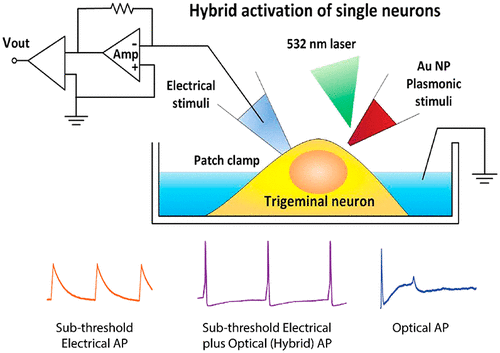Our official English website, www.x-mol.net, welcomes your
feedback! (Note: you will need to create a separate account there.)
Hybrid Electro-Plasmonic Neural Stimulation with Visible-Light-Sensitive Gold Nanoparticles.
ACS Nano ( IF 15.8 ) Pub Date : 2020-06-30 , DOI: 10.1021/acsnano.0c00722 Ratka Damnjanovic , Parveen Bazard , Robert D. Frisina , Venkat R. Bhethanabotla
ACS Nano ( IF 15.8 ) Pub Date : 2020-06-30 , DOI: 10.1021/acsnano.0c00722 Ratka Damnjanovic , Parveen Bazard , Robert D. Frisina , Venkat R. Bhethanabotla

|
Biomedical prosthetics utilizing electrical stimulation have limited, effective spatial resolution due to spread of electrical currents to surrounding tissue, causing nonselective stimulation. So, precise spatial resolution is not possible for traditional neural prosthetic devices, such as cochlear implants. More recently, alternative methods utilize optical stimulation, mainly infrared, sometimes paired with nanotechnology for stimulating action potentials. Infrared stimulation has its own drawbacks, as it may cause collateral heating of surrounding tissue. In previous work, we employed a plasmonic method for stimulation of an electrically excitable neuroblastoma cell line, which had limited success. Here, we report the development of a hybrid electro-plasmonic stimulation platform for spatially and temporally precise neural excitation to address the above deficiencies. Primary trigeminal neurons were costimulated in vitro in a whole-cell patch-clamp configuration with subthreshold-level short-duration (1–5 ms) electrical and visible light pulses (1–5 ms). The visible light pulses were aimed at a gold-nanoparticle-coated nanoelectrode placed alongside the neuron, within 2 μm distance. Membrane action potentials were recorded with a 3-fold higher success rate and 5-fold better poststimulation cell recovery rate than with pure optical stimulation alone. Also, electrical stimulus current input was being reduced by up to 40%. The subthreshold levels of electrical stimuli in conjunction with visible light (532 nm) reliably triggered trains of action potentials. This single-cell hybrid activation was reliable and repeatable, without any damage as observed with pure optical stimulation. This work represents an empirical cellular study of the membrane action potential response produced by the cultured primary sensory trigeminal neurons when costimulated with plasmonic and electrical (hybrid) stimulation. Our hybrid neurostimulation method can be used toward development of high-acuity neural modulation prosthetic devices, tunable for individual needs, which would qualify as a preferred alternative over traditional electrical stimulation technologies.
中文翻译:

可见光敏感金纳米粒子的混合电-肺神经刺激。
由于电流散布到周围组织,从而导致非选择性刺激,因此利用电刺激的生物医学假体具有有限的有效空间分辨率。因此,对于传统的人工神经人工设备(例如人工耳蜗),不可能实现精确的空间分辨率。最近,替代方法利用光学刺激,主要是红外线,有时与纳米技术配对以刺激动作电位。红外线刺激有其自身的缺点,因为它可能引起周围组织的附带发热。在以前的工作中,我们采用了等离激元方法来刺激电可激发的神经母细胞瘤细胞系,但效果有限。这里,我们报告了发展时空精确的神经激励的混合电等离子体刺激平台的发展,以解决上述缺陷。原发性三叉神经元体外在具有亚阈值水平短持续时间(1-5 ms)的电和可见光脉冲(1-5 ms)的全细胞膜片钳配置中。可见光脉冲对准2微米距离内与神经元并排放置的金纳米粒子涂层纳米电极。记录膜动作电位的成功率比单纯单纯光刺激高3倍,刺激后细胞恢复率高5倍。此外,电刺激电流输入最多减少了40%。亚阈值电刺激与可见光(532 nm)可靠地触发了一系列动作电位。这种单细胞杂合激活是可靠的和可重复的,没有任何损伤,如纯光刺激观察到的那样。这项工作代表了对等离子和电(混合)刺激共刺激时,由培养的初级感觉三叉神经元产生的膜动作电位反应的经验细胞研究。我们的混合神经刺激方法可用于开发高敏度神经调节假体设备,可针对个人需求进行调整,与传统的电刺激技术相比,它可作为首选替代产品。
更新日期:2020-06-30
中文翻译:

可见光敏感金纳米粒子的混合电-肺神经刺激。
由于电流散布到周围组织,从而导致非选择性刺激,因此利用电刺激的生物医学假体具有有限的有效空间分辨率。因此,对于传统的人工神经人工设备(例如人工耳蜗),不可能实现精确的空间分辨率。最近,替代方法利用光学刺激,主要是红外线,有时与纳米技术配对以刺激动作电位。红外线刺激有其自身的缺点,因为它可能引起周围组织的附带发热。在以前的工作中,我们采用了等离激元方法来刺激电可激发的神经母细胞瘤细胞系,但效果有限。这里,我们报告了发展时空精确的神经激励的混合电等离子体刺激平台的发展,以解决上述缺陷。原发性三叉神经元体外在具有亚阈值水平短持续时间(1-5 ms)的电和可见光脉冲(1-5 ms)的全细胞膜片钳配置中。可见光脉冲对准2微米距离内与神经元并排放置的金纳米粒子涂层纳米电极。记录膜动作电位的成功率比单纯单纯光刺激高3倍,刺激后细胞恢复率高5倍。此外,电刺激电流输入最多减少了40%。亚阈值电刺激与可见光(532 nm)可靠地触发了一系列动作电位。这种单细胞杂合激活是可靠的和可重复的,没有任何损伤,如纯光刺激观察到的那样。这项工作代表了对等离子和电(混合)刺激共刺激时,由培养的初级感觉三叉神经元产生的膜动作电位反应的经验细胞研究。我们的混合神经刺激方法可用于开发高敏度神经调节假体设备,可针对个人需求进行调整,与传统的电刺激技术相比,它可作为首选替代产品。











































 京公网安备 11010802027423号
京公网安备 11010802027423号